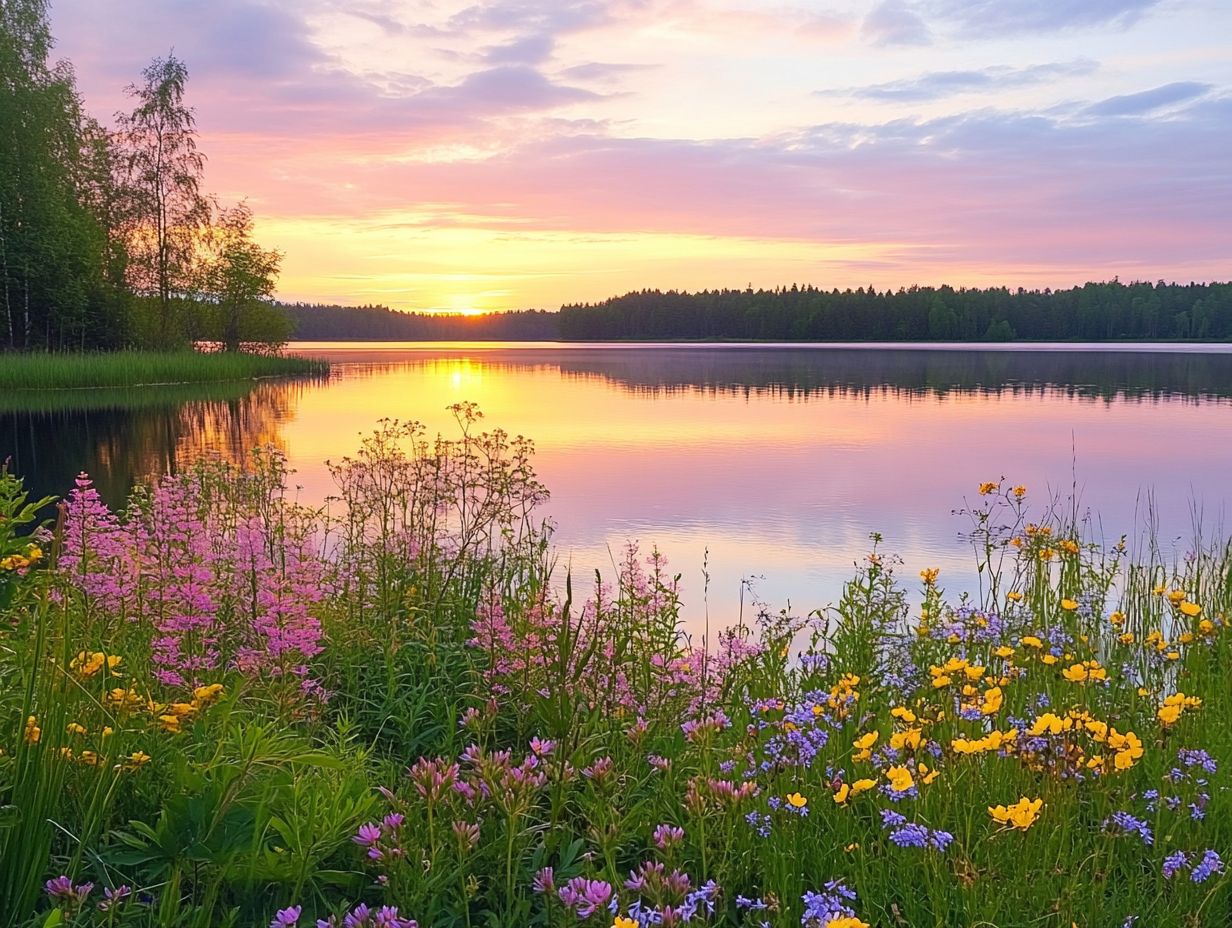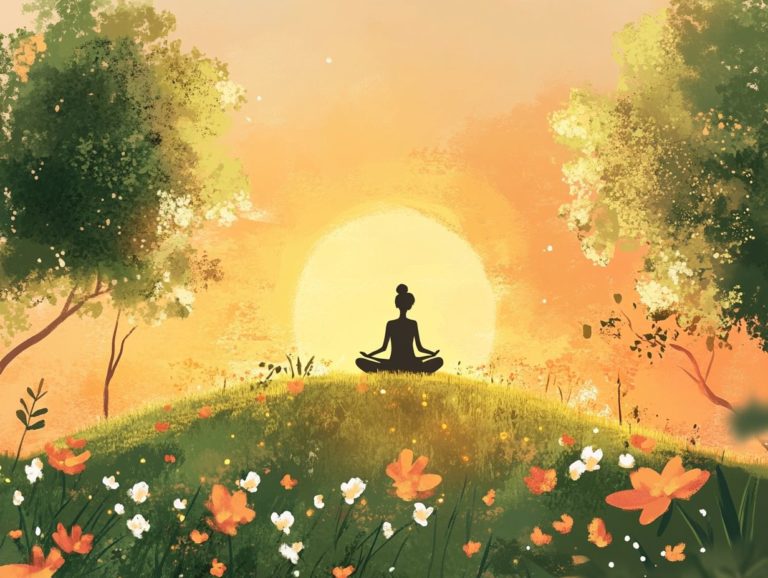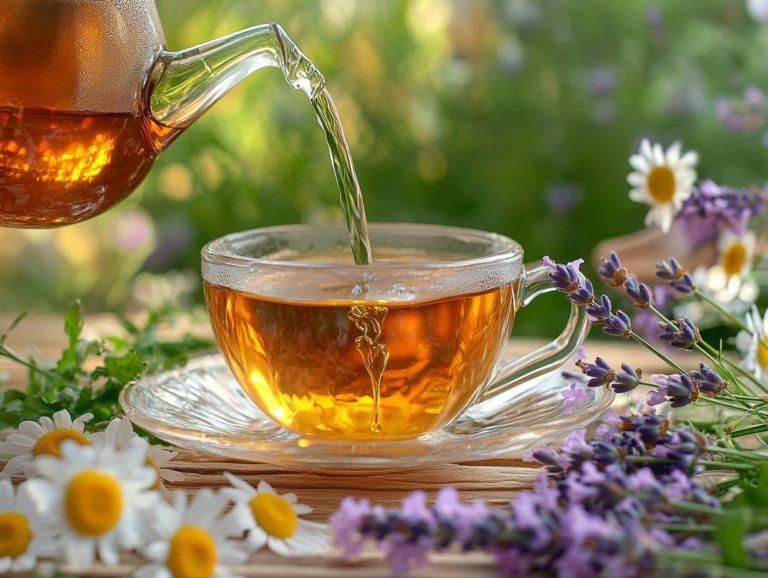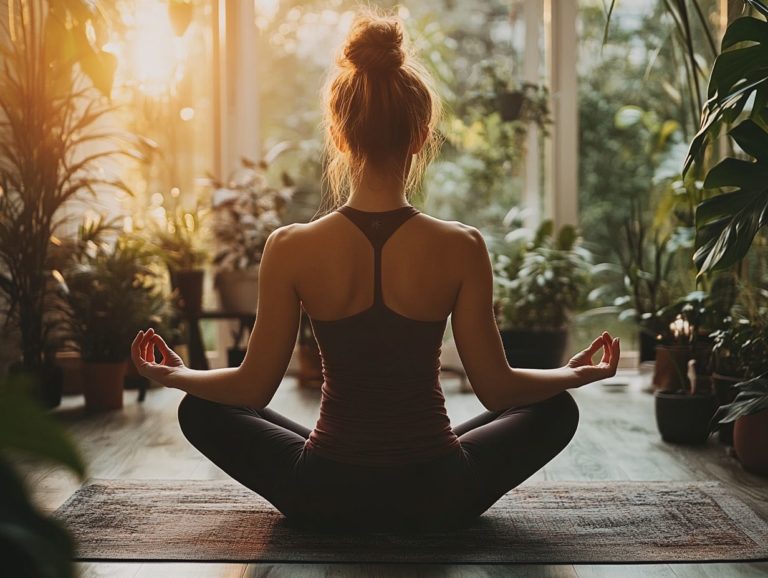5 Ways to Use Nature’s Colors for Calm
Creating a serene home environment is vital for your well-being. One of the most effective ways to achieve this is by embracing nature’s colors.
This article will guide you through five simple yet impactful methods to weave earthy tones, soothing blues, and natural light into your space. These elements foster a calming atmosphere. Alongside practical decor tips, you ll explore how colors influence your mood and uncover insights into the most soothing shades found in nature.
Get ready to discover how to transform your home into a tranquil retreat!
Contents
- Key Takeaways:
- 1. Incorporate Earthy Tones in Your Home Decor
- 2. Spend Time in Green Spaces
- 3. Use Blue for a Relaxing Atmosphere
- 4. Surround Yourself with Natural Light
- 5. Use Essential Oils for Aromatherapy
- How Do Colors Affect Our Mood?
- What Are the Most Calming Colors in Nature?
- What Are Some Other Ways to Incorporate Nature s Colors for Calm?
- How Can One Create a Colorful and Calming Environment at Home?
- Are There Any Colors That Should Be Avoided for a Calming Atmosphere?
- How Can One Use Color to Enhance Their Meditation or Yoga Practice?
- Frequently Asked Questions
- What are 5 Ways to Use Nature s Colors for Calm?
- How do calming colors affect our mood?
- What are some examples of calming colors found in nature?
- Can using nature’s colors for calm benefit our mental health?
- Are there any other ways to incorporate nature’s colors for calm?
- How can we use nature’s colors for calm in our busy daily lives?
Key Takeaways:

- Incorporate earthy tones in your home decor to create a soothing and natural atmosphere.
- Spending time in green spaces can reduce stress and promote relaxation.
- Blue is a calming color that can be used in various ways, such as through paint or decor, to create a tranquil environment.
1. Incorporate Earthy Tones in Your Home Decor
Incorporating earthy tones into your home decor can transform your living space and create a peaceful environment.
These nature-inspired hues soft greens, deep browns, and muted yellows bring a calming effect that enhances your emotional well-being and psychological health.
Imagine blending these colors into cohesive palettes that evoke comfort and warmth. Pairing rich terracotta with sandy beiges can establish a grounded look that invites relaxation.
Meanwhile, gentle olive greens combined with cream inspire serene and uplifting vibes. Choosing these colors helps you feel better by reducing stress and anxiety.
This mindful selection of decor can stimulate creativity and inspiration, helping you feel more connected to your surroundings. This connection enhances your mental clarity and focus, ultimately lifting the overall mood of your home.
2. Spend Time in Green Spaces
Spending time in green spaces is pivotal for your mental health and overall well-being.
These natural environments, with their vibrant hues and soothing atmospheres, can significantly diminish stress and elevate your emotional stability.
Have you ever felt a profound sense of tranquility while in nature? The sights and sounds of chirping birds, rustling leaves, and flowing water create a calming experience.
Engaging in activities like meditation or yoga in these serene settings amplifies mindfulness, deepening your connection to the world around you. Such practices not only reduce anxiety but also foster emotional resilience, enabling you to navigate life’s challenges with greater ease.
The therapeutic qualities of these green spaces offer a sanctuary where mental clarity and emotional wellness can truly thrive.
3. Use Blue for a Relaxing Atmosphere
The color blue is celebrated for its remarkable ability to cultivate a relaxing atmosphere and promote stress relief.
When you weave blue into your environment, it fosters a sense of calm and tranquility.
Different shades of blue, from the airy lightness of sky blue to the rich depths of navy, serve distinct purposes in decor and textiles, contributing to a serene look. Now is the time to integrate these calming hues into your life!
You can seamlessly integrate these hues into draperies, cushions, or wall art, collectively creating a visual balance that resonates beautifully with mindfulness practices.
Psychologically, blue is associated with feelings of stability and comfort, making it an ideal choice for spaces designed for meditation or relaxation.
By thoughtfully curating an environment that embraces these shades, you can elevate your ability to unwind, facilitating a deeper connection with your inner peace.
4. Surround Yourself with Natural Light

Natural light can greatly improve your mental health. It creates a vibrant, energizing space that reduces stress and boosts your mood.
Incorporating large windows, skylights, and reflective surfaces into your home design maximizes sunlight. This invites a sense of serenity and connection to the outdoors.
This infusion of light can invigorate your daily routines. It also supports mindfulness practices like yoga or meditation, as a sunlit space encourages deeper focus and relaxation.
Did you know? Natural light can supercharge your productivity and creativity while making you happier!
By thoughtfully designing your living spaces to prioritize light, you can cultivate a sanctuary that nurtures both your mind and spirit.
5. Use Essential Oils for Aromatherapy
Essential oils for aromatherapy transform your space into a sanctuary of calm. They enhance emotional responses, promote relaxation, and support your healing practices.
Take lavender essential oil, for example. It s well-known for its ability to reduce anxiety and improve sleep quality. This makes it the perfect companion for unwinding after a long day.
On the other hand, eucalyptus oil clears the mind and opens up the airways, encouraging deeper breathing during meditation.
You can incorporate these oils into your mindfulness routines through diffusers or topical applications. The soothing scents ground you, facilitating a deeper connection to the present moment.
This nurtures an inner calm that supports both emotional and mental healing.
How Do Colors Affect Our Mood?
Colors wield a remarkable influence over your mood and emotional responses. Certain hues can elicit feelings of calmness or inspiration, highlighting how colors affect our feelings.
Take shades of green; they re often tied to nature and renewal, crafting an environment that encourages relaxation. Blue tones have a soothing effect, making them ideal for meditation spaces.
Then there s yellow, with its cheerful essence, which can lift your spirits. However, it may become overwhelming if used excessively.
By integrating these calming colors into your surroundings, you can create a supportive atmosphere that enhances your emotional well-being.
What Are the Most Calming Colors in Nature?
The most calming colors in nature, like soothing greens and tranquil blues, foster emotional responses that promote relaxation.
These hues evoke serene landscapes, where vibrant greens stir a sense of renewal. Deep blues, reminiscent of ocean waves, elicit feelings of peace.
By surrounding yourself with these natural tones through home decor, clothing choices, or artwork you can significantly influence your mood and create a harmonious environment.
Incorporating such colors into your daily life, whether through lush indoor plants or calming ocean scenes in your workspace, enhances your well-being.
Choose these soothing shades to cultivate a serene atmosphere that nurtures both mental clarity and emotional stability.
What Are Some Other Ways to Incorporate Nature s Colors for Calm?

Incorporating the colors of nature into your life can be a delightful journey. This journey involves a variety of activities from selecting decor items to diving into creative projects all designed to evoke a sense of calm and emotional stability.
For instance, choosing earthy tones for your furniture or wall paint creates a serene atmosphere that invites relaxation. In your gardening endeavors, opt for plants with lush greens and vibrant blooms to transform your outdoor spaces into havens of tranquility.
Engaging in art projects that use natural pigments or feature landscapes enhances mindfulness. You’ll immerse yourself in the creative process, reflecting your personal style while harmonizing with a soothing environment.
These choices foster a deeper connection to both nature and your inner self.
How Can One Create a Colorful and Calming Environment at Home?
Creating a colorful and calming environment in your home is about selecting hues that resonate with your emotions. Incorporate elements of nature to support mindfulness and tranquility, benefiting your mental health and emotional well-being.
Soft shades of blue and green evoke feelings of serenity and balance. These colors are ideal choices for bedrooms or cozy reading nooks. When combining these colors, use neutral tones like soft whites or gentle grays as a backdrop to avoid overwhelming your senses.
Integrating natural elements like wooden furniture or indoor plants enhances that calming effect. Adding textures like linen or cotton in your textiles introduces warmth and comfort, creating a harmonious balance that invites relaxation into your life.
Are There Any Colors That Should Be Avoided for a Calming Atmosphere?
Avoid vibrant or overly stimulating shades like bright red or neon hues in spaces designed for calm. These colors can trigger emotional responses that lead to stress and anxiety.
In contrast, soft hues such as gentle blues, muted greens, or warm earth tones promote tranquility. Picture a pale blue mimicking the serene sky or a soft green echoing nature s soothing presence; both significantly reduce stress levels.
Understanding how colors affect emotions helps you select shades that enhance the beauty of your space. Incorporate soothing colors through paint, decor, or textiles to cultivate a harmonious environment that encourages peace of mind and emotional balance.
How Can One Use Color to Enhance Their Meditation or Yoga Practice?
Thoughtful color use can significantly enhance your meditation or yoga practice. This creates a calming atmosphere that supports emotional balance and mindfulness, transforming your experience into something more restorative and effective.
Incorporate hues like soft blues and greens to evoke tranquility and grounding. Warm tones such as gentle yellows or soft oranges uplift your spirit, promoting positivity and motivation during more vigorous sessions.
By creating a harmonious environment with color, you boost aesthetic appeal and shape the mood and focus of your practice. Choose the right palette to cultivate a sanctuary where you can retreat from daily distractions for profound introspection and connection during each session.
Frequently Asked Questions

What are 5 Ways to Use Nature s Colors for Calm?
1. Incorporate calming colors into your home decor, like soft greens and blues, to create a soothing environment.
2. Spend time in nature, surrounded by the calming colors of the outdoors. This can enhance your mental health and promote relaxation.
3. Practice color meditation, a technique where you focus on a specific calming color to find peace and connect with your emotions.
4. Use calming colors in your wardrobe, such as neutral tones or pastel hues, to create a calm vibe throughout your day.
5. Bring calming colors into your work environment through office decor or desktop backgrounds. This can inspire creativity and boost productivity.
How do calming colors affect our mood?
Calming colors can positively affect our mood by promoting relaxation and reducing stress and anxiety. They are essential for emotional and psychological health.
These colors can also create a sense of balance and harmony in our surroundings, contributing to our overall well-being.
What are some examples of calming colors found in nature?
Some calming colors found in nature include shades of green, blue, and purple, along with soft earthy tones like beige and pale yellow. These hues reflect the beauty of each season spring, summer, autumn, and winter.
Water, trees, and flowers are excellent sources of these calming colors, providing inspiration for your personal palette.
Can using nature’s colors for calm benefit our mental health?
Yes! Incorporating nature’s colors into our daily lives can significantly impact our mental health. It enhances our emotional responses and promotes a vibrant lifestyle.
Studies have shown that exposure to calming colors helps reduce stress and encourages relaxation, ultimately benefiting our overall well-being and supporting emotional healing.
Are there any other ways to incorporate nature’s colors for calm?
Absolutely! There are many other ways to use nature’s colors for calm beyond home decor and clothing. Creative activities that integrate soothing hues can be very effective.
Dive into incorporating calming colors into your artwork, journaling, or even your food choices.
How can we use nature’s colors for calm in our busy daily lives?
One way to incorporate nature’s colors in our busy lives is by taking breaks to focus on a calming color. You can look at a photo or close your eyes and visualize it for a moment of peaceful reflection.
We can also include more calming colors in our surroundings and daily activities, like taking a walk in a green park or enjoying a meal with calming colors present.






